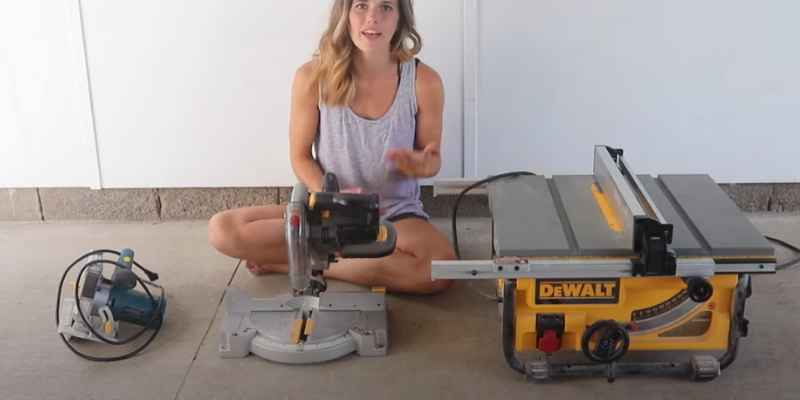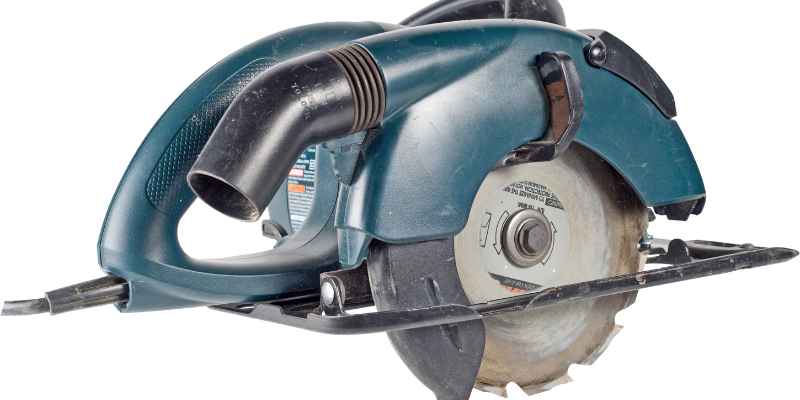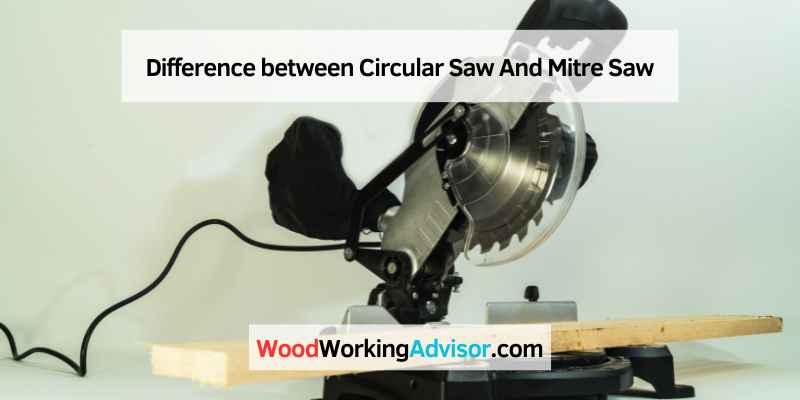Circular and miter saws are used for cutting wood, but they have different purposes. A circular saw is a handheld power tool to make long, straight cuts. On the other hand, a miter saw is a stationary power tool used to produce precise, angled cuts.
Two types of saws are commonly used for cutting wood: circular and miter saw. Both have advantages and disadvantages, so choosing the right one for your project is essential. The blade is the main difference between a circular and a miter saw.
A circular saw has a round blade that spins, while a miter saw has a flat edge that oscillates. This means that a circular saw can make both rip cuts (cuts along the grain of the wood) and cross cuts (cuts across the grain of the wood), while a miter saw can only make cross cuts. Another difference is in the size of the amount.
A circular saw can make much longer cuts than a miter saw, so it’s better suited for larger projects. However, a miter saw can make more precise cuts, so it’s better for smaller projects where accuracy is essential. So which one should you use?
It depends on your project. If you need to make long or rip cuts, go with a circular saw.

Can a Circular Saw Be Used As a Miter Saw?
A miter saw is a tool for making precise cuts at various angles. A circular saw is a powerful tool that uses a rotating blade to cut through the material. So, can a circular saw be used as a miter saw?
The answer is yes and no. While a circular saw can make some cuts similar to those made by a miter, the saw cannot make all the same kinds of cuts. And, even if it could make all the same types of cuts, it would not do so with the same precision or ease as a miter saw.
There are two main types of miter cuts: crosscuts and miters. Crosscuts are made when the workpiece is positioned across the blade and are generally used for cutting boards to length or trimming ends off lumber. Miters are made when the workpiece is positioned at an angle to the edge and are often used for creating picture frames or crown molding.
A circular saw can make crosscuts but cannot make miters (at least not without some severe jiggery-pokery). This is because the blade on a circular saw is fixed in place, which always cuts at 90 degrees to the workpiece. To make a mitered cut with a circular saw, you need to position your workpiece at an angle and then rotate it as you feed it into the blade – not exactly an easy feat!
So, while you can technically use a circular saw as a miter saw, we wouldn’t recommend it unless you’re very experienced and have access to proper safety equipment (like gloves, eye protection, and hearing protection). If you need to make precise mitered cuts, your best bet will still be using a dedicated miter saw.
Do I Need a Circular Saw And a Miter Saw?
If you’re planning on doing a lot of woodworking or carpentry, you’ll need both a circular and miter saw. Here’s why: A circular saw is great for making long, straight cuts in lumber.
It can also make rough cuts in plywood and other sheet goods. On the other hand, a miter saw is perfect for making precise angled cuts. This is essential for things like trim work, molding, and cabinetry.
So which one should you get first? If you’re starting, we recommend getting a good-quality circular saw. Once you have that, you can always add a miter saw later.
Is a Chop Saw the Same As a Circular Saw?
Chop saws and circular saws are powerful tools that can be used to make woodcuts. However, they are not the same tool. Circular saws have a blade that is mounted on an arbor.
The blade is held in place by a flange. The arbor is attached to a motor, which powers the edge. Circular saws can be used to make rip cuts, cross cuts, and miter cuts.
Chop saws have a blade that is mounted on the arm. The arm is attached to a base. The base is attached to a motor, which powers the edge.
Chop saws can only be used to make miter cuts and crosscuts.
What is a Mitre Saw Used For?
A miter saw is a specialized type used to make precise cuts at various angles. Unlike a standard hand saw, which is limited to making only 90-degree cuts, a miter saw can cut curves up to 45 degrees in either direction. This makes it an essential tool for anyone who needs to do any woodworking that involves angled cuts, such as crown molding or picture frames.
There are two basic miter saws: the chop saw, and the sliding compound miter saw. Chop saws are the more basic and affordable option, while sliding compound miter saws offer more features and versatility (and come with a higher price tag). No matter what type of miter saw you choose, they all operate similarly.
You start by clamping down your workpiece so it doesn’t move around while cutting it. Then you set the angle you want to miss using the adjustment knob on the side of the saw. Once your pitch is placed, you pull the trigger and let the blade do its work.
Mitre saws can be used on various materials beyond wood, such as PVC piping and aluminum siding. However, they are most commonly used by carpenters and other woodworkers to make quick, accurate cuts on pieces of lumber.
Circular Saw Vs. Table Saw
There are a few critical differences between circular saws and table saws that you should know before making a purchase. Here’s a breakdown of each type of saw and its key features:
Circular Saws:
-More affordable than table saws -Can be used for a variety of projects, such as cutting lumber, sheet goods, or pipe -Can be handheld or mounted to a stand
-Blade is exposed, so there is a greater chance of kickback (when the blade suddenly stops and kicks back towards the user)
Table Saws:
-More expensive than circular saws
-Best for larger projects that require more accuracy, such as cabinetmaking or woodworking projects
Circular Saw Vs. Skill Saw
When it comes to saws, there are many options on the market. It can be hard to decide which one is right for your needs. If you’re trying to choose between a circular saw and a skill saw, there are a few things you need to consider.
The first thing you need to think about is what you’ll be using the saw for. If you’re only going to be doing simple tasks like cutting lumber for a deck or trimming some boards, then a skill saw will probably suffice. However, if you’re planning on doing more complex projects like framing or cabinetry work, you’ll need the power and precision that a circular saw can provide.
Another important consideration is the size of the projects you’ll be working on. If you’re only working on smaller projects, a skill saw will do just fine. But if you’re planning to tackle larger jobs, you’ll need a circular saw.
Finally, think about your budget. Circular saws are generally more expensive than skill saws, so if cost is an issue, that may be your deciding factor. Overall, both types of saws have their pros and cons.
It depends on your needs and which one is right for you. So take some time to consider your project requirements before making your final decision.
Miter Saw Vs. Circular Saw for Beginners
When choosing between a miter, and a circular saw, there are a few things to consider. If you’re a beginner, then the most important factor is probably going to be the price. Miter saws are typically more expensive than circular saws, so if you’re on a budget, a circular saw is probably the better option.
Another thing to consider is the type of cuts you need to make. A circular saw will suffice if you only need to make straight cuts. However, a miter saw is necessary to create angled or compound cuts.
Finally, consider the size of the projects you’ll be working on. If you only plan on working on small projects, then either type of saw will work fine. However, if you’re planning on tackling more extensive projects, a miter saw is likely your best bet since it can handle tougher cuts faster than a circular saw can.
Miter Saw Or Circular Saw for Framing
When choosing between a miter or a circular saw for framing, there are several things to consider. First, think about the type of project you’re working on. If you’re doing a small project, a miter saw may be the better option because it’s more precise.
However, a circular saw will be faster and easier to use if you’re working on a large project. Another thing to remember is the size of the material you’re working with. A miter saw can handle more minor pieces of wood, while a circular saw is better for more significant amounts.
Keep this in mind when making your decision. Finally, think about your budget. Miter saws tend to be more expensive than circular saws, so if cost is a factor, that may sway your decision.
Whatever tool you choose, please read the instructions carefully before using it. And always wear safety gear when operating either type of saw!
Miter Saw Circular Saw Combo
A miter saw is a tool to make clean, precise cuts in wood. It’s a necessity for any serious woodworker. A circular saw is another essential tool for anyone who works with wood.
It’s great for making quick, rough cuts. So, what happens when you combine these two essential tools into one? You get a miter saw/circular saw combo!
This combo tool is the best of both worlds. It’s perfect for making both precision and rough cuts in wood. If you’re looking for a versatile, all-in-one solution for your woodworking needs, look no further than a miter saw/circular saw combo.
This combo tool will make your life much easier and help you get the job done right every time.
Circular Saw Vs. Miter Saw Vs. Table Saw
There are three main types of saws that are commonly used in woodworking: the circular saw, the miter saw, and the table saw. Each has its strengths and weaknesses, so it’s essential to choose the right one for the job. Circular Saws: Circular saws are handheld power tools that use a spinning blade to cut through wood.
They’re relatively inexpensive and easy to use, making them a good choice for basic cutting tasks. However, they can be challenging to control, so it’s essential to practice before using one on a project. Miter Saws: Miter saws are stationary power tools with a blade that can be tilted to create angled cuts.
They’re more expensive than circular saws, but they’re also much easier to control. This makes them ideal for precise cuts on molding or trim work. Table Saws: Table saws are the most significant and potent type available.
They’re usually only found in shops or commercial settings, as they require a large amount of space and can be dangerous if not used properly. However, their size and power make them perfect for making precision cuts on larger pieces of wood.
Circular Saw Vs. Jigsaw
There are many saws on the market, and it can be hard to decide which is suitable for your project. Do you need a powerful circular saw or a more precise jigsaw? In this article, we’ll compare these two popular types of saws so you can make an informed decision.
Circular saws make quick, straight cuts through thick materials like lumber. They’re also suitable for making rough cuts on plywood and other sheet goods. On the other hand, jigsaws are better suited for intricate cutting jobs and working with thinner materials.
A circular saw is a good choice if you’re looking for a versatile one that can handle various projects. If you need precision and control for delicate cutting jobs, then a jigsaw is better.

How to Use a Circular Saw
A circular saw is a power tool that can be used to make quick, clean cuts in wood. It is a versatile tool that can be used for various tasks, such as cutting lumber for framing or trim or making cuts for molding and trim installation. When using a circular saw, remember a few things to ensure safe and accurate operation.
First, always use the blade guard that comes with the saw. This will help protect you from the blade in case of kickback (when the edge suddenly stops and reverses direction). Second, be sure to use the correct type of blade for the material you’re cutting – using the wrong knife can damage both the saw and the material you’re trying to cut.
Third, support long pieces of lumber on sawhorses or another stable surface, so they don’t sag or wobble while cutting them. And finally, always pay attention to what you’re doing – it’s easy to get distracted when operating a power tool like this, and accidents can happen quickly if you’re not paying attention. With these tips in mind, let’s look at how to use a circular saw.
The first step is to set up your work area – ensure you have plenty of space and that all your materials are within reach. Next, clamp or otherwise secure your workpiece, so it doesn’t move while you’re working on it. Once your piece is attached, measure where to make your cut and mark it with a pencil, so you have a guideline.
Now it’s time to start cutting! Place the base plate of the saw on the wood at your cut line and ensure that the blade is lined up with your mark before turning on the power. When ready, slowly lower the edge into contact with the wood and apply enough pressure to begin cutting through it; once started, continue moving forward at a steady pace until finished.
Be careful not to stop or pause mid-cut – this could cause kickback if restarting from an unsupported position.
Conclusion
When it comes to saws, there are many different options on the market. Two popular types of saws are circular saws and miter saws. So, what’s the difference between these two types of saws?
Circular saws are handheld power tools that can be used for various tasks, such as cutting wood boards or pipes. They typically have a circular blade that is powered by an electric motor. On the other hand, Miter saws are stationary power tools designed specifically for making clean, precise cuts at angles.
They also have a circular blade and a sliding arm that allows you to make angle cuts.



2 thoughts on “Difference between Circular Saw And Mitre Saw”